
Introduction
Embarking on a weight management journey often feels like navigating through a maze of misinformation and myths, especially when Hashimoto's Thyroiditis is part of the equation. This autoimmune disorder, characterized by the immune system's attack on the thyroid gland, disrupts hormone production, impacting metabolism and consequently, weight. This article aims to dismantle the barriers of myths surrounding Hashimoto's and weight loss, shedding light on truths to empower and guide you through this challenging yet achievable journey.
Hashimoto's Thyroiditis: A Primer
Hashimoto's disease, frequently misunderstood, has a profound effect on an individual's body weight and energy levels. Manifesting symptoms such as fatigue, weight gain, difficulty concentrating, dry skin and hair, constipation, hair loss or slow growth, enlarged neck, joint stiffness and pain, slower than normal heart rate, and cold intolerance. It underscores the critical need for accurate diagnosis and a deep understanding of its implications. Hashimoto’s means your body is fluctuating from mostly low thyroid to high thyroid and you might see a yo-yo effect in your weight. Recognizing these symptoms as signals from your body, rather than mere inconveniences, is the first step towards managing your health and weight effectively.
Debunking the Myths
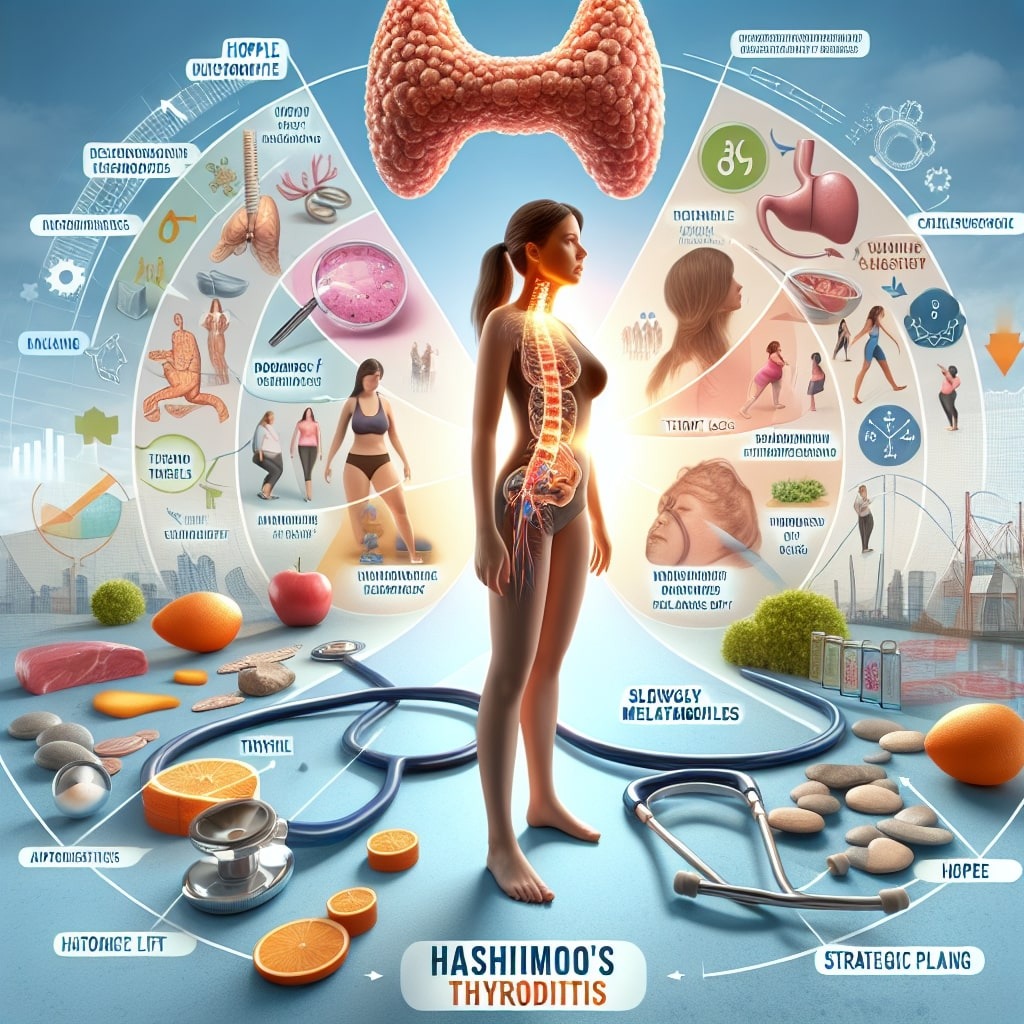
The myth that losing weight with Hashimoto's Thyroiditis is impossible is not only misleading but also disheartening for many. It paints a picture of despair for those already struggling with the symptoms of this autoimmune disease. However, the truth is far more hopeful. With the right strategies, understanding, and support, weight loss and management are achievable goals. Below, we explore detailed strategies and practical tips to empower women in their quest for a healthier lifestyle amidst the challenges of Hashimoto's.
Understanding the Impact of Hashimoto's on Metabolism
First and foremost, it's crucial to understand how Hashimoto's affects your body, particularly your metabolism. This condition often results in hypothyroidism, a state in which your thyroid gland doesn't produce enough hormones, leading to a slowed metabolism. Recognizing this is key to adapting your weight loss strategy to meet your body's unique needs.
Collaborating with Healthcare Providers
Optimize Thyroid Hormone Levels: Regular monitoring and adjusting of your thyroid hormone replacement medication, under the guidance of an endocrinologist or a healthcare provider specializing in thyroid disorders, can help in managing your metabolic rate and supporting weight loss.
Comprehensive Health Assessment: Insist on a thorough evaluation not just limited to TSH levels, but also including Free T3, Free T4, and antibody tests, along with Iodine, your hormone levels for Testosterone, Progesterone, and Estrogen. This comprehensive approach allows for a more tailored treatment plan. Some supplements that can help you through your challenges include American Ginseng, Ashwagandha, Black Cohosh Root and Licorice Root. Talk with your doctor about these supplements.
Tailored Dietary Plans
Focus on Anti-inflammatory Foods: Incorporate a diet rich in anti-inflammatory foods such as turmeric, ginger, fatty fish (like salmon, mackerel, and sardines), nuts, and seeds. These foods can help mitigate inflammation associated with Hashimoto's and support overall thyroid health.
Balanced Nutrition: Emphasize a balanced intake of macronutrients (proteins, fats, carbohydrates) and micronutrients (vitamins and minerals). Consult with a nutritionist who understands Hashimoto's to design a meal plan that addresses your specific needs, ensuring you receive all necessary nutrients without excessive caloric intake.
Elimination Diet Trial: Consider experimenting with an elimination diet under professional guidance to identify any food sensitivities or triggers that may exacerbate your symptoms or hinder weight loss, such as gluten, dairy, or soy. Stop taking these foods for at least 6 weeks to see how your body responds. Then slowly reintroduce one at a time to see if your body reacts to the food source.
Adapting Your Exercise Regimen
Low-Impact Exercises: Start with low-impact exercises such as walking, swimming, or yoga. These activities are less stressful on the body and can be particularly beneficial for those with Hashimoto's, helping to boost energy levels and support weight loss without overburdening the thyroid. Lifting weights, or using your body weight to start, is also an essential part of keeping your bones and muscles strong so you can stay mobile and independent.
Progressive Intensity: Gradually increase the intensity and variety of your workouts as your strength and endurance improve. Activities like strength training will strengthen your muscles, which in turn can increase your resting metabolic rate.
Listen to Your Body: Pay close attention to how your body responds to different types of exercise. If you experience increased fatigue or other negative symptoms, adjust your activity level accordingly. Remember, consistency over intensity is key.
Lifestyle Modifications
Stress Management: Chronic stress can exacerbate Hashimoto's symptoms and impact your ability to lose weight. Incorporate stress-reduction techniques such as meditation, deep breathing exercises, or gentle yoga into your daily routine.
Quality Sleep: Ensure you're getting enough restorative sleep. Poor sleep can affect your metabolism and appetite-regulating hormones, making weight management more challenging. Make sure to get on a regular sleep schedule. Wake to see the sunrise to get your body’s circadian rhythm back to a regular schedule.
Stay Hydrated: Adequate hydration is essential for overall health and can aid in weight loss. Aim for at least 60-80 oz. of water a day, or more if you're very active.
Staying Motivated and Supported
Set Realistic Goals: Celebrate small victories and set achievable milestones. This helps in maintaining motivation and keeping track of progress. Also journal your progress to see the changes along the way to truly see your progress.
Seek Support: Connect with others who are navigating similar challenges. Support groups, whether online or in-person, can provide valuable advice, encouragement, and understanding. Studies show that people who work with a coach are 80% more likely to succeed with their goals.
Embracing Patience and Persistence
Finally, it's important to approach your weight loss journey with patience and persistence. Hashimoto's can make the process slower than it might otherwise be, but with consistent effort and adjustments based on your body's responses, progress will come. Celebrate every step forward, no matter how small, and remember that improving your health and well-being is a marathon, not a sprint. It is a lifestyle change.
Myth 1 Conclusion
By debunking the myth that losing weight with Hashimoto's is impossible and arming yourself with the right strategies and knowledge, you can embark on a journey toward a healthier lifestyle. Remember, every individual's experience with Hashimoto's is unique, and what works for one person may not work for another. Stay in tune with your body, and don't hesitate to seek professional guidance to tailor these strategies to your personal needs and goals.
Myth 2: Eating Less is the Secret to Weight Loss
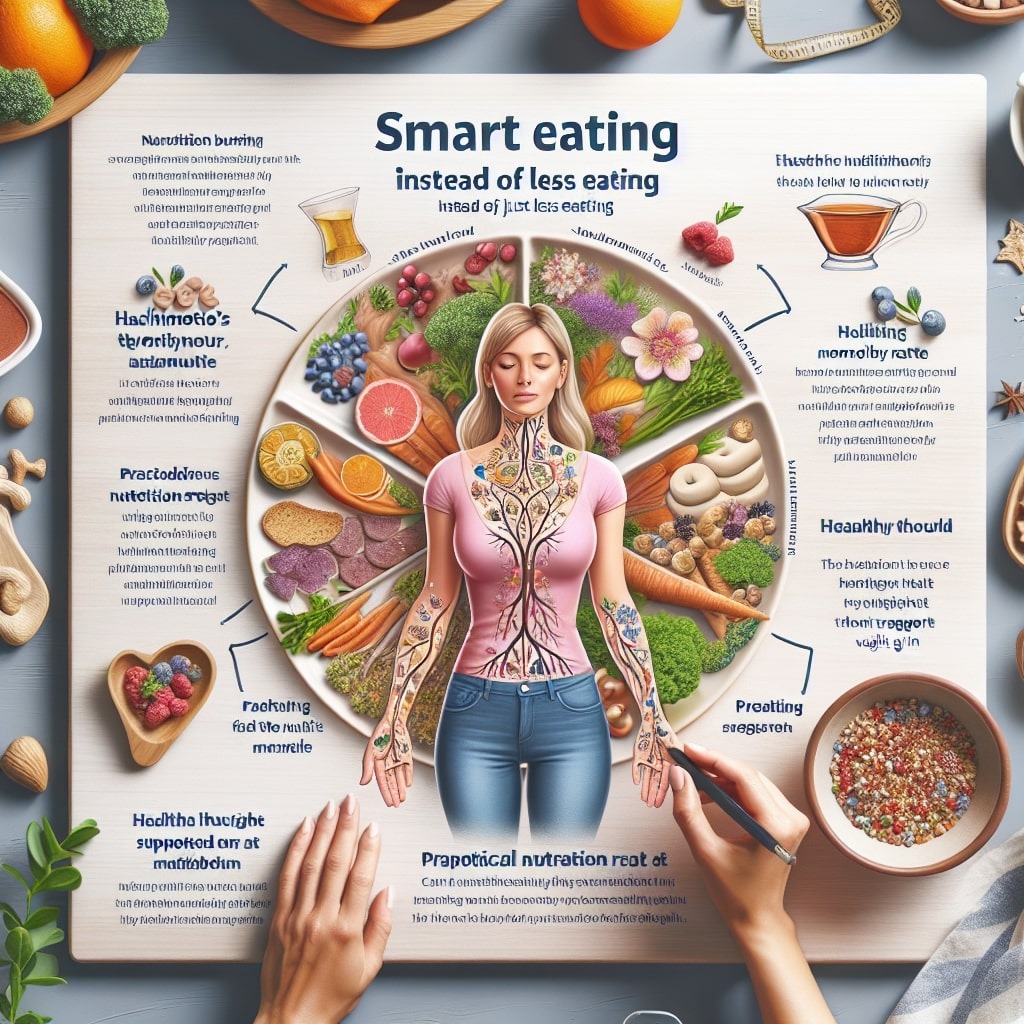
The myth that simply eating less is the secret to weight loss pervades many discussions around dieting and health, particularly for those battling Hashimoto's Thyroiditis. However, this approach oversimplifies the complex relationship between food, metabolism, and autoimmune conditions. For individuals with Hashimoto's, the focus should not solely be on eating less but rather on eating smarter. Below are detailed strategies and practical tips designed to empower women in their journey toward a healthier lifestyle amidst the challenges of Hashimoto's.
Understanding Nutritional Needs
Hashimoto's impacts the thyroid, which plays a crucial role in regulating metabolism. This condition often leads to a slowed metabolic rate, making it essential to consume foods that support thyroid function and overall health without promoting weight gain.
Focusing on Nutrient-Dense Foods
Incorporate Whole Foods: Emphasize whole, unprocessed foods in your diet. Vegetables, lean proteins, low glycemic fruit like berries, and healthy fats like avocado, coconut, nuts, seeds, and fatty fish like salmon, mackerel, and sardines provide essential nutrients and help maintain a feeling of fullness.
Choose Anti-inflammatory Foods: Foods rich in omega-3 fatty acids, such as fatty fish, flaxseeds, and walnuts, can help reduce inflammation associated with Hashimoto's. Additionally, incorporating turmeric with black pepper, ginger, and green leafy vegetables can support your body's anti-inflammatory processes.
Balancing Macronutrients
Protein-Rich Foods: Include a source of lean protein at every meal to help sustain muscle mass and keep you feeling satisfied. Options like chicken, fish, legumes, and tofu are excellent choices.
Healthy Fats: Avocados, olive oil, coconut oil, nuts and seeds contain healthy fats that support hormonal balance and satiety, preventing overeating.
Complex Carbohydrates: Opt for complex carbs such as sweet potatoes, quinoa, chia seeds, flax seeds, and brown rice. These provide sustained energy and help regulate blood sugar levels, which is crucial for weight management.
Managing Portion Sizes Intelligently
Listen to Your Hunger Cues: Learn to recognize when you're truly hungry versus when you're eating out of habit or emotion. Eating slowly and mindfully can help you become more attuned to your body's signals. Drink an 8 oz glass of water before the meal, as many times we are more thirsty than hungry.
Use Smaller Plates: This simple trick can help control portion sizes naturally without the need to count calories obsessively.
Timing Your Meals
Regular Meal Times: Eating at regular intervals can help stabilize your metabolism and energy levels throughout the day. Skipping meals, especially breakfast, can lead to overeating later in the day. I like to eat a large breakfast with 4 eggs, and berries with a handful of walnuts, ½ an avocado, a sprinkle of organic unsweetened coconut flakes, ½ cup of organic coconut milk, and a glass of 1 cup of kefir, as long as you are not lactose intolerant. Eat the protein first to slow the digestion of the carbs from the fruit to lessen the glucose impact on your body.
Consider Intermittent Fasting: Some people with Hashimoto's find intermittent fasting beneficial, as it can improve insulin sensitivity and support weight loss. The most ideal fast is at least 16 hours, with an 8 hour eating window, called a 16:8 fast. There are benefits to longer fasting as well. However, this approach isn't suitable for everyone, so consult with a healthcare professional before trying.
Addressing Food Sensitivities
Many individuals with Hashimoto's experience food sensitivities that can exacerbate symptoms and hinder weight loss efforts.
Elimination Diet: Temporarily removing common triggers like gluten, dairy, soy, and processed sugars can help identify sensitivities. Stop taking these foods all together for at least 6 weeks to see how your body responds. Slowly reintroduce these foods one at a time while monitoring your symptoms to determine which foods, if any, cause adverse reactions.
Staying Hydrated
Drink Plenty of Water: Adequate hydration is essential for overall health and can aid in weight management. Sometimes, thirst is mistaken for hunger, so staying hydrated might help curb unnecessary snacking. 60-80 oz of water per day. Drink 8 oz of water before each meal to make sure it’s not thirst driving your hunger.
Seeking Professional Guidance
Work with a Nutritionist: A nutritionist or dietitian familiar with Hashimoto's can help create a personalized eating plan that supports your weight loss goals while ensuring you receive the nutrients your body needs.
Emphasizing Quality Over Quantity
Ultimately, the key to managing weight with Hashimoto's isn't just eating less but focusing on the quality of the food you consume. Nutrient-dense, anti-inflammatory foods that support thyroid health and reduce autoimmune symptoms can pave the way for successful weight management.
Myth 2 Conclusion
By shifting the focus from merely reducing caloric intake to adopting a more holistic and informed approach to nutrition, women with Hashimoto's can find a sustainable path to weight loss and improved health. Remember, every individual's journey is unique, so it's essential to listen to your body and adjust your dietary choices to meet your specific needs and goals.
Myth 3: Exercise Exacerbates Hashimoto’s Symptoms
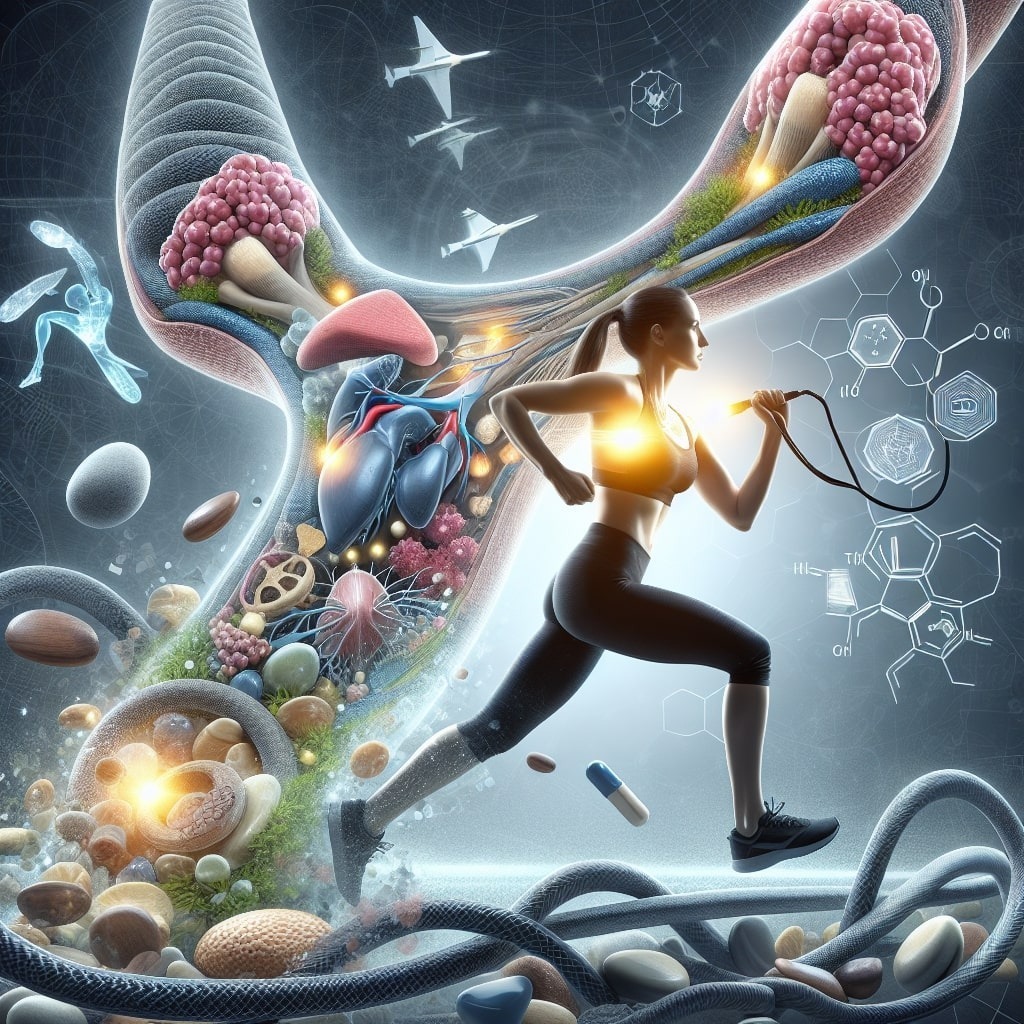
The misconception that exercise exacerbates the symptoms of Hashimoto’s Thyroiditis can deter many from engaging in physical activity, potentially missing out on its numerous health benefits. In reality, when approached correctly, exercise can be a powerful tool in managing Hashimoto’s symptoms and aiding in weight loss. Here’s how to navigate exercise as part of a healthier lifestyle while dealing with Hashimoto’s.
Understanding the Role of Exercise in Hashimoto’s
Exercise can help improve cardiovascular health, boost energy levels, and promote weight loss, all of which are beneficial for individuals with Hashimoto’s. It can also enhance mood and reduce stress, factors that are crucial for managing autoimmune conditions.
Starting at a Slower Pace
If you are someone who hasn’t been working out regularly, start slow.
Low-Impact Activities: Begin with low-impact exercises such as walking, swimming, or cycling. These activities are less stressful on the joints and can be easily adjusted to your current fitness level.
Yoga and Pilates: Both are excellent for increasing flexibility, strength, and stress relief. They also offer the added benefit of mindfulness, which can help in managing the emotional challenges of living with Hashimoto’s.
If you are someone who has worked out regularly, watch for signs of dizziness, low energy levels, and additional recovery pain:
Dial-down Activities: Listen to your body and workout with lower intensity, and leave enough energy before you are worn out.
Do exercises close to the ground if dizzy: planks, core work, sitting bicep curls, bench workouts, etc. Work with a nutritionist and your healthcare provider to check your blood pressure and nutrient levels to ensure proper nutrition for your workouts.
Gradually Increasing Intensity
Strength Training: Incorporating light strength training can help build muscle mass, which in turn improves metabolism, brain and bone health. Start with light weights or bodyweight exercises and gradually increase as you become stronger.
Cardiovascular Exercises: As your endurance improves, you can slowly introduce more vigorous activities, such as brisk walking, jogging, or group fitness classes, ensuring to monitor how your body responds.
Listening to Your Body
Adjust According to Symptoms: Pay close attention to how your body responds to different types of exercise. If you notice increased fatigue or other adverse effects, scale back and allow your body time to recover.
Rest and Recovery: Ensure you’re giving your body ample time to rest between workouts. Overexerting yourself can lead to increased inflammation and worsen symptoms.
Incorporating Variety
Mix It Up: Engaging in a variety of exercises can help prevent boredom and keeps the body challenged. Try different activities to find what you enjoy and what suits your body best.
Outdoor Activities: Whenever possible, take your exercise outdoors. Activities like hiking or outdoor cycling can provide the added benefits of fresh air and vitamin D.
Creating a Consistent Routine
Set Realistic Goals: Establish achievable exercise goals to stay motivated. Whether it’s walking a certain number of steps each day or attending a yoga class twice a week, having clear objectives can help keep you on track. Keep a journal to watch your progress.
Schedule Your Workouts: Treat your exercise time as you would any important appointment. Scheduling workouts can help ensure they become a non-negotiable part of your routine. And journaling can keep you motivated to keep achieving new goals.
Seeking Professional Guidance
Work with a Fitness Professional: If you’re unsure about how to start exercising safely with Hashimoto’s, consider working with a personal trainer experienced in working with clients with chronic conditions. They can tailor a program to your specific needs.
Consult with Your Healthcare Provider: Before starting any new exercise regimen, it’s wise to consult with your doctor or a healthcare professional who understands your medical history and current condition.
Emphasizing Recovery and Self-Care
Post-Exercise Recovery: Incorporate practices such as stretching, foam rolling, or even gentle yoga poses after workouts to aid in recovery and flexibility.
Mindfulness and Relaxation: Techniques such as meditation, deep breathing exercises, or simply taking quiet time for yourself can help in managing stress and promoting overall well-being.
Myth 3 Conclusion
The belief that exercise worsens Hashimoto’s symptoms is a myth that can hinder your path to a healthier lifestyle. With the right approach, physical activity can be a beneficial component of managing Hashimoto’s, aiding in symptom relief, and promoting weight loss. By starting slowly, listening to your body, and incorporating a variety of activities, you can make exercise a safe and enjoyable part of your wellness journey. Remember, the goal is to support your body and enhance your health, so choose activities that bring you joy and leave you feeling energized rather than depleted.
Myth 4: Medication Alone Will Fix Weight Issues
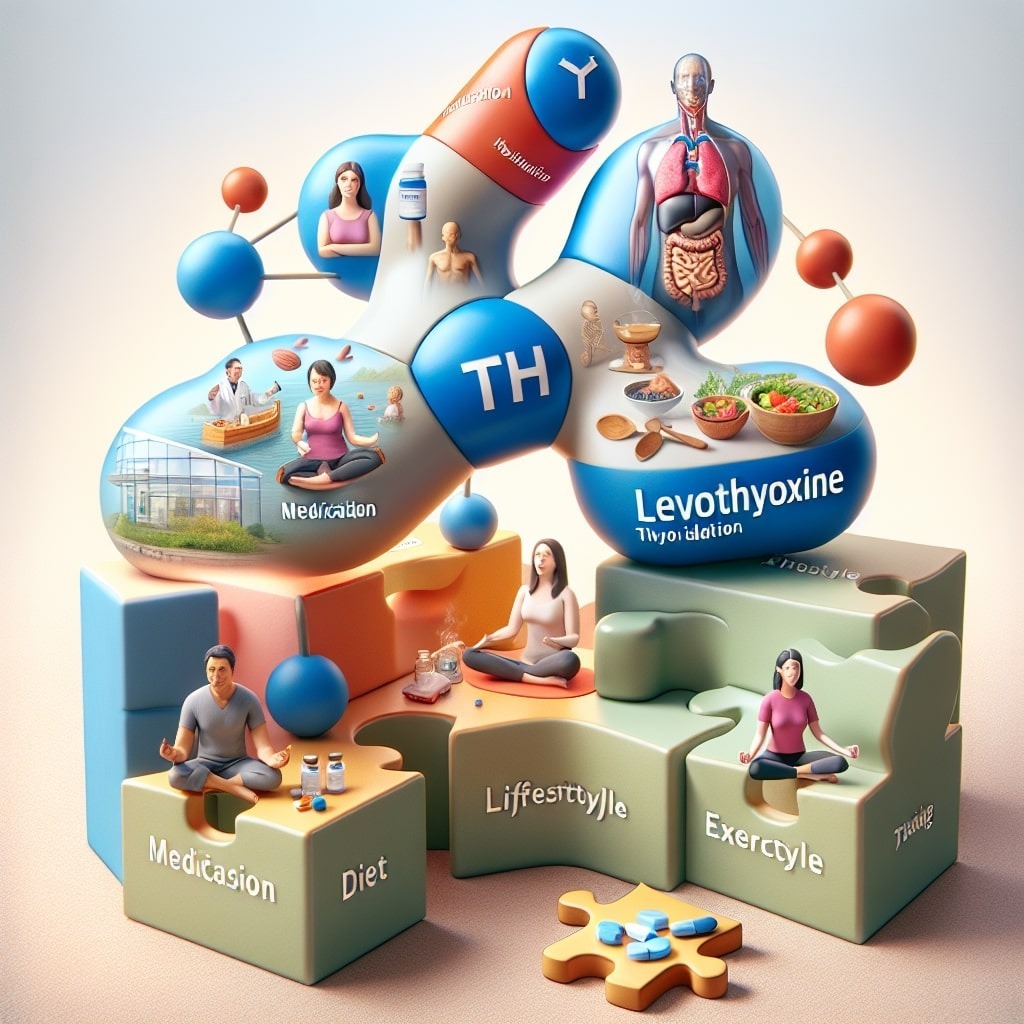
The belief that medication alone can resolve weight issues for individuals with Hashimoto's Thyroiditis simplifies a complex issue. While thyroid hormone replacement therapy is crucial for managing Hashimoto's, relying solely on medication without addressing diet, lifestyle, and exercise often leads to frustration and stagnant progress. Here's how to build a comprehensive approach that supports weight management and overall health alongside medication.
Understanding the Role of Medication
Thyroid Hormone Replacement: Medications like levothyroxine are essential for those with Hashimoto's, as they compensate for the thyroid's inability to produce enough hormones. However, optimal thyroid function is just one piece of the puzzle in achieving a healthy weight.
Integrating Nutrition and Diet
Anti-inflammatory Diet: Emphasize foods that reduce inflammation and support thyroid health. Focus on a diet rich in fruits, vegetables, lean proteins, and healthy fats.
Food Sensitivities: Identify and eliminate foods that trigger inflammation or digestive issues. Common culprits include gluten, dairy, and soy. An elimination diet can be helpful in pinpointing sensitivities.
Hydration: Drinking sufficient water is essential for metabolism and helps reduce appetite, aiding in weight management.
Embracing a Holistic Lifestyle Approach
Stress Management: Chronic stress can exacerbate Hashimoto's symptoms and impede weight loss efforts. Incorporate stress-reduction techniques such as meditation, yoga, or deep breathing exercises into your daily routine.
Sleep Quality: Prioritize good sleep hygiene. Lack of sleep can disrupt hormone balance, including hormones that regulate appetite and weight.
Social Support: Engage with communities or support groups for individuals with Hashimoto's. Sharing experiences and tips can provide motivation and reduce feelings of isolation.
Adopting a Customized Exercise Regimen
Personalized Activity Plan: Exercise is not one-size-fits-all. What works for one person may not work for another, especially when dealing with an autoimmune condition. Start with low-impact activities and gradually increase intensity based on your body’s response.
Consistency Over Intensity: Regular, moderate activity is more beneficial than sporadic, intense workouts that can stress the body and trigger Hashimoto's symptoms.
Monitoring and Adjusting Treatment
Regular Check-ups: Ongoing monitoring of your thyroid levels and symptoms with your healthcare provider is crucial. This ensures that your medication dosage is optimal and adjusts to your body's changing needs.
Holistic Healthcare Team: Consider working with a team that might include an endocrinologist, a dietitian that specializes in autoimmune conditions, and a physical therapist or personal trainer knowledgeable about Hashimoto's. This integrated approach ensures all aspects of your health and weight management are addressed.
Setting Realistic Expectations
Patience is Key: Weight loss with Hashimoto's can be slower than expected. Celebrate small milestones and be patient with your body.
Focus on Overall Health: Rather than fixating solely on weight loss, concentrate on improving your overall health and quality of life. Increased energy, better sleep, and reduced symptoms are all significant achievements.
Myth 4 Conclusion
Dispelling the myth that medication alone will fix weight issues is crucial for those living with Hashimoto's. A comprehensive approach that includes tailored nutrition, manageable exercise, stress reduction, adequate sleep, and may include medication offers the best path forward. By adopting a holistic strategy and working closely with healthcare professionals, you can manage your weight effectively while living with Hashimoto's. Remember, the journey to a healthier weight is not just about the numbers on the scale but about building a lifestyle that supports your overall well-being.
 Add Row
Add Row  Add
Add 









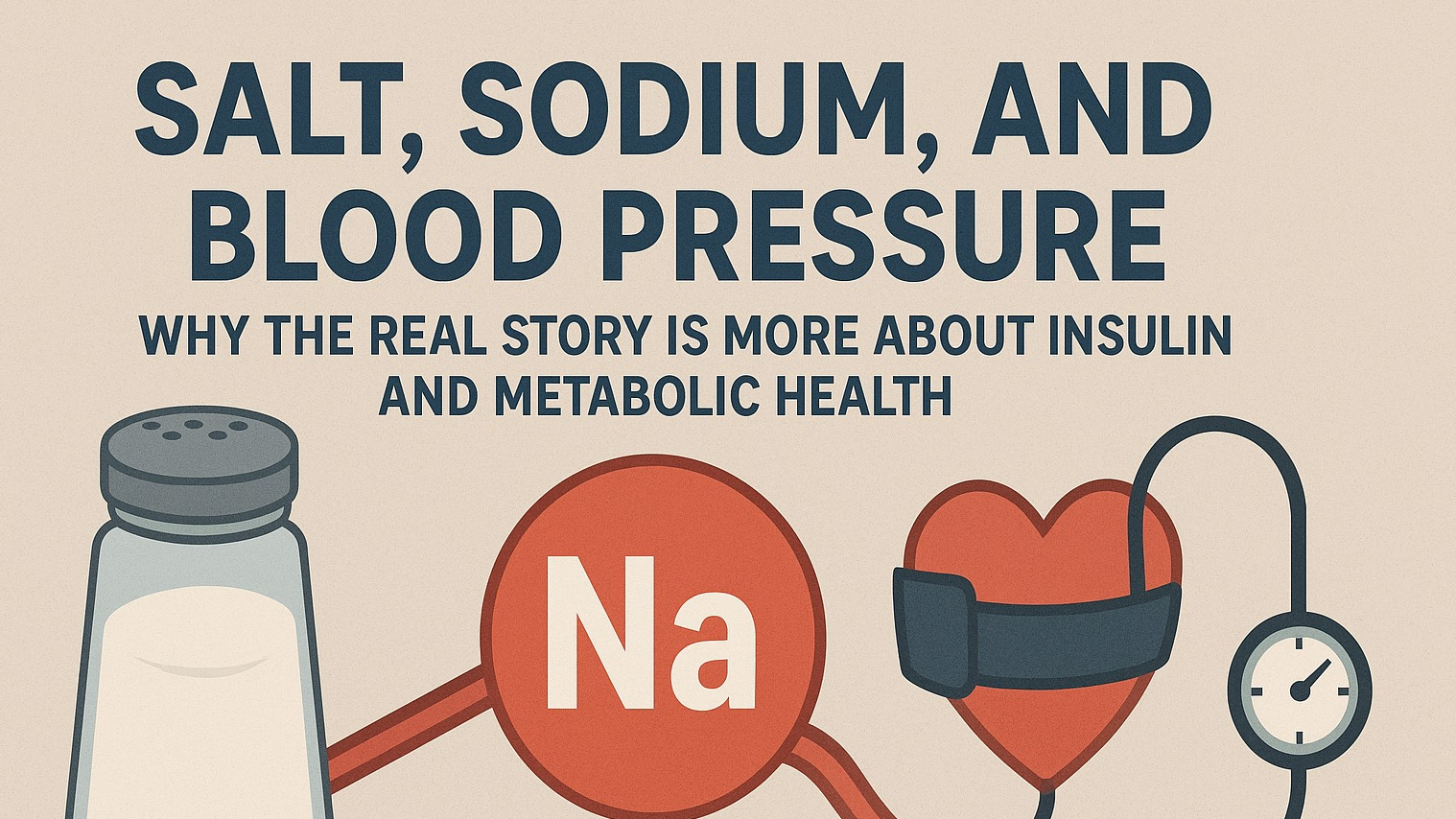
Write A Comment